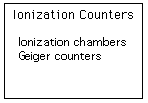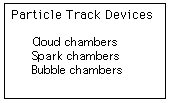Radiation Detection
Nuclear radiation and x-rays are ionizing radiation and they can be detected from the ionizing events they produce.



Radiation DetectionNuclear radiation and x-rays are ionizing radiation and they can be detected from the ionizing events they produce.    |
Index |
| HyperPhysics***** Nuclear | Go Back |
Ionization CountersRadiation detection can be accomplished by stretching a wire inside a gas-filled cylinder and raising the wire to a high positive voltage. The total charge produced by the passage of an ionizing particle through the active volume can be collected and measured. Different names are used for the devices based on the amount of voltage applied to the center electrode and the consequent nature of the ionizing events. If the voltage is high enough for the primary electron-ion pair to reach the electrodes but not high enough for secondary ionization, the device is called and ionization chamber. The collected charge is proportional to the number of ionizing events, and such devices are typically used as radiation dosimeters. At a higher voltage, the number of ionizations associated with a particle detection rises steeply because of secondary ionizations, and the device is often called a proportional counter. A single event can cause a voltage pulse proportional to the energy loss of the primary particle. At a still higher voltage, an avalanche pulse is produced by a single event in the devices called Geiger counters. |
Index |
| HyperPhysics***** Nuclear | Go Back |
Scintillation CountersRadiation detection can be accomplished by the use of a scintillator: a substance which emits light when struck by an ionizing particle. The scintillation detectors used in the Geiger-Marsden experiment were simple phosphor screens which emitted a flash of light when struck by an alpha particle. Modern scintillation counters may use single crystals of NaI doped with thallium. Electrons from the ionizing event are trapped into an excited state of the thallium activation center and emit a photon when they decay to the ground state. Photomultiplier tubes are used to intensify the signal from the scintillations. The decay times are on the order of 200 ns and the magnitude of the output pulse from the photomultiplier is proportional to the energy loss of the primary particle. Organic scintillators such as a mixture of polystyrene and tetraphenyl butadine. They have the advantage of faster decay time ( about 1 ns) and can be molded into experimentally useful configurations. |
Index |
| HyperPhysics***** Nuclear | Go Back |
Particle Track DevicesRadiation detection can take the form of devices which visualize the track of the ionizing particle. Cloud chambers can show the track of a passing particle which can be photographed. D. A. Glaser's invention of the bubble chamber in 1952 largely replaced the cloud chamber. Placed in an intense magnetic field, the curvature of the tracks of the primary particles and their products give information about their charge and momentum. Spark chambers can also visualize the tracks of particles and has the advantage that the paths can be recorded electronically. |
Index |
| HyperPhysics***** Nuclear | Go Back |